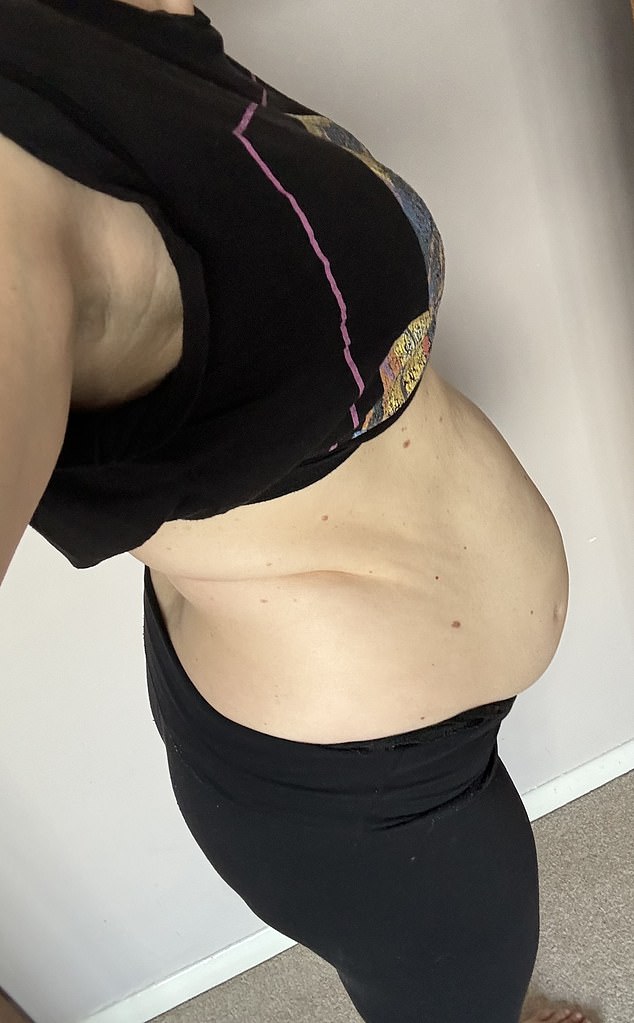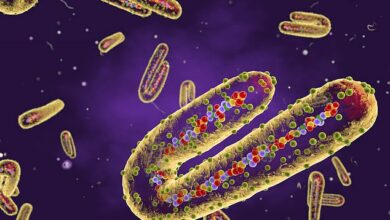You can get rid of your mother’s tum: Having a baby bump can cause women’s muscles to sag after birth and the stomach to bulge – but there’s a breakthrough treatment if you know what to ask for



At least once a week, Lauren Askew is congratulated on her pregnancy, but she is not pregnant.
“It’s so embarrassing and disturbing,” she says. ‘If it’s a stranger, I just go along with it, because I don’t dare say anything.
“But if it’s someone I’m going to see again, I have to say, ‘Actually, it’s a condition.'”
Lauren, 42, gave birth to twins in June 2021 and has severe diastasis recti – a condition where the abdominal muscles separate during pregnancy and do not return to their normal position.
Although some degree of separation is normal with any pregnancy – as hormonal changes cause the ligaments to relax – the muscles normally come back together after birth.
But in one in three women, the muscles and connective tissue of the rectus abdominis – the ‘six-pack’ muscles that run vertically down the front of your abdomen – separate too far, so they can’t return to their position.
The condition is usually caused by pregnancy, especially if a woman has a large belly – like Lauren’s twin pregnancy – or is very small, overweight or becomes pregnant again quickly after a previous birth.
Genetics and prolonged pushing during labor are linked to the condition. It can also be caused or made worse if a woman exercises intensely before rebuilding core strength in the weeks after birth – especially with sit-ups or certain yoga poses that cause abdominal muscles to swell.

Lauren, 42, gave birth to twins in June 2021 and has severe diastasis recti – a condition where the abdominal muscles separate during pregnancy and do not return to their normal position

In most moderate cases, when the muscles do not come back together naturally, physical therapy exercises in the first year after birth usually help. In the photo: a woman with diastasis recti
Rarely, strenuous exercise that strains the abdominal muscles, such as weight lifting, can cause the condition in both men and women who have never given birth.
In about 5 percent of mothers with the condition, the gap is so wide and the tissues supporting the muscles are so weak that the stomach bulges out like a pregnancy belly.
Lauren estimates that there is at least two inches of distance between her abs, which makes her look about six months pregnant.
In these severe cases, the damaged muscles are unable to properly support the spine and internal organs, meaning women can suffer from back pain, bowel problems and urinary incontinence.
They can also develop hernias, where internal organs push out through the opening.
The lack of trunk support can even mean that women can only roll out of bed sideways because they are physically unable to sit upright.
Although she is otherwise fit, Lauren has difficulty bending down to put on her shoes. She also has chronic back pain and digestive problems such as pain and gas.
Women struggle not only with the physical symptoms, but also with low body confidence and even depression, says Tina Mason, a specialist women’s health physiotherapist at the Women’s Health Brighton clinic.
A 2020 study in the journal BMC Women’s Health found that women were affected “in multiple ways,” both physically and psychologically.
“Think of it as blowing up a balloon,” says Tina Mason.
‘If you inflate a balloon a little and then let the air out, it returns to its original shape.
“But if you keep inflating it, there comes a point where the balloon is stretched so far that it will never regain its shape even if you let go of all the air.”
Lauren, who lives in Portslade, East Sussex, says it has had a ‘huge impact’ on her life. She needed days off from her job as a pediatric speech therapist and received therapy for a bad mood.
Although her husband Andrew, 43, has been supportive, she feels the condition has affected their intimacy.
“It affects your self-confidence, your relationship – you feel bad all the time,” she says. “I’m a social person, but now I have anxiety about going out because I don’t feel like I can wear anything that will look good.”
While the rest of her body has returned to a pre-pregnancy size 10 to 12, she now wears size 14 to 16 leggings and loose tops to cover her belly.
In most minor to moderate cases of diastasis recti, targeted physical therapy exercises in the first year after birth usually help if the muscles do not come back together naturally. But surgery is the only option for severe cases.
Yet the required tummy tuck (commonly known as a ‘tummy tuck’) is not routinely available on the NHS, which classifies it as cosmetic.
David Floyd, a plastic surgeon in London, believes that surgery for severe cases should be considered ‘functional’.
He points to research showing that most patients see significant improvements in their overall health after surgery – in a Swedish study published in the journal BJS Open, women followed for three years after surgery all experienced improvements in core stability, muscle strength and quality of life.
The physical and psychological benefits of surgery are “huge”, Mr Floyd said. “Women get their core strength back, their back pain goes away, they can sit up in bed, they can run around with their kids, [urine leakage] really improves.’
Local NHS guidelines in some areas say repair surgery should be offered if the gap is larger than 2.5cm, causing ‘disability or significant functional impairment’, the woman has had six months of physiotherapy and it has been at least a year since the birth. But patient groups and surgeons say most NHS commissioners are not following this.
But while the NHS does not offer tummy tucks after pregnancy, it does offer other cosmetic procedures: breast reduction or enlargement for cases where breast size causes back pain or psychological problems, for example, or for prominent ears that ’cause significant distress’.
“Women are expected to just live with this condition, which causes real suffering,” says Tina Mason. ‘Of course having a child is a choice, but if a man suffered a knee injury after choosing to take up exercise, the NHS would treat that.’
She adds that most of her patients are young, fit women who have lost their pregnancy weight and are doing their physical therapy exercises – doing everything they can to help themselves and still look pregnant.
Tina Mason says the refusal to operate on them is ‘short-sighted’ as some studies have found links between diastasis recti and conditions such as hernias and back problems, which the NHS does treat.
“Ultimately the NHS will have to pay to fix these knock-on circumstances, when they could have simply dealt with the problem in the first place,” she says.
A tummy tuck costs privately £8,000 to £15,000. It is a relatively simple two-hour procedure, although recovery is painful and slow.
Diastasis recti is not part of a routine postnatal check – Lauren first raised her concerns during her six-week check-up with the GP, but was told it was ‘early days’ and should go away on its own. But three months after giving birth, with no improvement, she saw a specialist physiotherapist privately.
They diagnosed diastasis recti and put her on an exercise program. Despite a lot of hard work, there has been little change. Originally optimistic that exercise would work, she says: ‘I now know that surgery is the only solution in my case because the muscles on the sides of my abdominal muscles are also very stretched.’
In August, Lauren saw a private plastic surgeon, but the operation costs £10,000 and there is a waiting list: Lauren hopes to get a spot next year.
The physiotherapist who diagnosed Lauren was concerned that she might have a hernia and therefore referred her back to her GP. But it took almost three years of back and forth before she finally saw an NHS specialist in September, only to find out that she did indeed have a hernia.
Although the NHS would repair this separately, Lauren wants to avoid two major procedures while caring for her twins, so she pays privately to have both repairs done at the same time.
She and Andrew are in danger of going into debt to cover costs. Lauren works extra shifts at work, and the couple plans to use credit cards and get financial help from Lauren’s parents.
‘It will be difficult, but I am lucky that I can find a way to pay; a lot of women can’t do that,” she says. ‘The condition can be very debilitating, but with treatment women can return to health and work.’
An NHS England spokesperson said: ‘Pelvic and abdominal physiotherapy is usually the first-line treatment for conditions such as diastasis recti as it is effective in many cases, but ICBs [local health authorities] can have other procedures performed by their patients on site if necessary.
‘Individual treatment plans should be decisions between doctors and patients, taking into account the latest clinical guidelines.’




